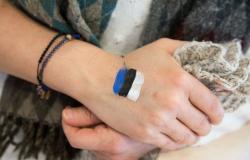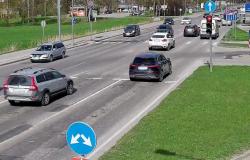Līvbērze, Jelgava county, is a small village and parish center 15 kilometers from Jelgava. On March 18, the Livbērze Youth Initiative Center started its work here.
Erita and Sara study in the 8th grade at the local elementary school, Melanija, a 10th grader, travels to the center from Jelgava. The center is visited by 30 young people per month, mostly under 18 years of age. Meitenes Latvijas Radio shows the premises of the center and the list of monthly classes is displayed on the blackboard.
“‘Garfield’ is our cooking classes. Every month or week we make something delicious with the youngsters. Because Garfield is a cat who likes to eat. We like to eat too.”
Amanda Melder, head of the Livbērze Youth Initiative Center, was an active young person herself until recently and was involved in a wide variety of regional activities.
“You have to make the young person trust you, but you can’t be too friendly with them. You have to understand that you are the leader, but you also have to listen and understand them.
Hours ended and others also come here to spend their free time until they wait for the bus home, because many are from neighboring parishes, neighboring villages. Then they stay here and go home,” said Meldere. The center is sometimes also visited by young adults who are scheduled to receive job search training.
Amanda Melder, head of Livbērze Youth Initiative Center
Photo: Daina Zalamane / Latvian Radio
For the municipality, work with young people is a priority
There are nine youth initiative centers and five youth rooms in Jelgava county. Valters Siksna, the head of the municipality’s youth department, said that youth centers are created in all parishes where there are at least 240 residents and young people should be involved in the life of the parish as volunteers.
One youth center is allocated 7,000 to 10,000 euros by the municipality of Jelgava region for various activities during the year. The center organizes four events in one month.
On the other hand, the funding allocated to youth facilities is lower – on average from 1,500 to 2,000 euros, but the settings are also lower – one event per month.
“Then there are also wages, of course, but at the moment, Jelgava County prioritizes youth work and understands its importance and meaning. As a youth department, we provide volunteer work in every parish. For example, when there is an event in the cultural center, the cultural center calls the youth center, or you can help with master classes. Parish holidays are in every parish, youth centers connect to organize them,” said Siksna.
Valters Siksna, Head of the Youth Affairs Department of Jelgava County Municipality
Photo: Daina Zalamane / Latvian Radio
Centers also have their own set goals. Currently, the municipality aims to reach 24% of the number of young people in parishes. “Currently, as a county, we reach 18%, which is an average of about 730 young people aged 13 to 25 that we addressed. We currently have [darbinieki] in 16 parishes, but there are two more parishes – Platone parish and Valgunde parish, where we need to find employees so that youth work can start and continue there.”
The creation of the center started with the camp
In Branka, which is located 10 kilometers from Jelgava, in the industrial district, the “Tuvu” association, which helps poor families, initially found premises. Lāsma Cimermane, the chairman of the board of the association, revealed that when they started helping families, cooperation with young people also began:
“Working with young people, it quickly became clear to us that this is the way we can bring some kind of change to that family through the young people. It all started with the camps. We create an environment where they are accepted, where we show them love and acceptance.”
Ēvalds Kārkliņš has been managing the Branku Youth Initiative Center for less than 3 months, but has been working with young people for 10 years.
There is no school in Branka, so young people spend time here when they return from school, and boys are more active.
“I am a youth worker, a hiking leader, a non-formal education trainer and an ornithology enthusiast, I fish a lot, I go hunting. I have also tried to work in various other fields, industries, and I have realized that work for young people is a matter of my heart,” said Kārklins. Currently, fishing events are already planned, because the head of the center is fond of the theme of nature.

Association “Tuvu” representatives Lāsma Cimermane and Zane Rautmane, Branki youth initiative center manager Ēvalds Kārklinņš
Photo: Daina Zalamane / Latvian Radio
Youth centers work in four directions
The funding allocated to youth centers this year in the budget of Jelgava county municipality is 73,900 euros. This is 15,000 euros more than a year ago, because in March, two youth initiative centers started working in Jelgava region – in Līvbērze and Glūda.
Siksna, head of the youth affairs department, explained that youth centers in the region work in 4 directions:
“We need to strengthen young people’s digital skills, which will be needed in the labor market. We need to provide programming training. Then our second priority is civic participation, volunteer work. In principle, the elections are also approaching now, and then the task of the centers is to prepare young people and talk to them about the elections, explain , what it is, how this democratic country works, and that it is important to vote. The third priority is health and well-being, under which we put hiking, cycling, talking about mental health. We invite various specialists to discuss and talk to young people. The final priority we have entrepreneurship – how to plan your finances, how to plan your time. We have four big orientations a year in each season, when all the centers come together to create a sense of belonging to the region. Once every two months we have an evening of talks called “Icebergs” about topical issues for young people topics. It was just about entrepreneurship, then we are talking about how a young person, for example, should start a business. We have an initiative contest once a year, where we allocate 300 euros to each parish for young people’s ideas.”
But what should be improved in the operation of youth centers?
Lāsma Cimermane, chairwoman of the board of the association “Tuvu”, admitted that the leaders of youth centers change due to low pay:
“We have to talk about money again, but I think so
a young person who does not have a family, who lives alone, can work here, the working hours are also such that a couple of days are until 20.00 in the evening, which is perhaps not so suitable for a family person. I think that payment should be higher.”
Around 100 young people visit the most popular center per week
Oskars Schults is the manager of the youth center “Pakāpiens” of Jelgava state city municipality. The center opened on March 1 in Pārlielupe, or the so-called RAF district. Oskar has been working with young people for 10 years. Before that, he worked in the probation service.

Oskars Schults, head of the Jelgava state city municipality, youth center Pakāpiens
Photo: Daina Zalamane / Latvian Radio
Three youth centers operate in Jelgava. The most popular at the moment is the newest and most modern – the “Pakāpiens” center, which is visited by 100 young people a week. It was created in cooperation with Lithuanians, Šiauliai Municipality, and its purpose is to promote the integration of children and young people exposed to social risk into society.
“Here is a workshop. Creative chaos at the moment, but there are practically all hand tools that could be there, so that young people can work here with wood, metal. Fitness room. It’s such a guy’s world here? Not only that, no, girls with actively use the rowing machine, here is a multitool where you can pump up in various ways, with the help of resistance bands, you can work, heavy dumbbells, this is freely available to everyone. The kitchen area, where everything is needed,” said Šulcs. In cooperation with the Jelgava branch of the Latvian Children’s Fund, food is also available in the center once a week. Also, various games, freely available computers, internet and television are provided for young people.
“We have a condition in the center, let’s say, for the word llama, the boys pump up 10 times, the girls squat,” revealed Schultz.
The center as a place where “street youth” get to know a different life
Employees of the center attract young people by going to their favorite gathering places, said Kristīne Karbeška, an employee of the “Pakāpiens” center:
“We offer the possibility that you can come and spend your free time. Someone is waiting for their friends, they don’t want to come alone. These are street youth, they prefer to be in their own company. You can’t smoke here, you can’t use rude words.”
Karbeška is convinced that youth centers can help “street children”, because it is a place for young people to get to know a different life.
“Then you can see that there are other people,” said Karbeška about working with “street children”.
The center is also planning training for young people, because, according to Schultz, the head of the “Pakāpiens” center, the time of covid has had consequences: “Young people are less motivated, less willing to attend some kind of events. 20 apply for the event, in the end 10 or half of those who applied . That’s already good.”
Young people of all groups should be thought of
Nils Konstantinov, head of the adolescent and youth psychotherapy center, assessed that the biggest challenge for youth centers is to precisely define their target audience:
“Young people are very diverse, and no center, no initiative will appeal to all young people. This is also the most problematic thing, because of course we want to be open to all young people, but it never works that way. In my experience and what I have seen from my colleague’s experiences , where problems often arise that
these youth centers, they’re targeting, like, young people who are quite well off, who are quite motivated and tidy. And then those who are, in turn, the risky young people, do not go there, because they do not feel they belong there.
And then it turns out that in the municipality, for example, there may be many places where good young people go, but it doesn’t really work for those who need it the most. And, of course, also the other way around – if there is a place where risky young people go a lot, then the good, decent young people will not want to go there again. This approach will be truly successful if all groups of young people are taken into consideration.”
Tags: priority municipality youth centers opened Jelgava region Article
-








